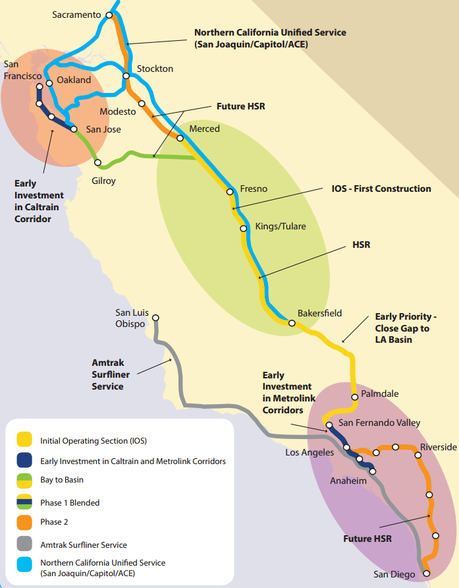By 2029, the system will run from San Francisco to the Los Angeles basin in under three hours at speeds capable of over 200 miles per hour. The system will eventually extend to Sacramento and San Diego, totaling 800 miles with up to 24 stations. The cost for this first phase of construction is estimated to be $68 billion. By 2030 it is expected to save 2 to 8 million tons of CO2—an equivalent to closing one coal-fired plant.

Map of early investments and statewide benefits of California’s high-speed rail system. (Credit: California High-Speed Rail Authority). Click to enlarge.
The California High-Speed Rail Authority released a report on the benefits of the high-speed rail program on the reduction of California’s greenhouse gas emissions. The report details how the high-speed rail system will provide a high-quality, environmentally friendly interregional transportation system and help reduce GHG emissions as well as deliver other environmental benefits including:
- Using methodologies consistent with state practice, an estimated 4 to 8 million metric tons of CO2 saved by 2030, as if the state turned off a coal fired power plant.
- Greenhouse gas savings from the first year of operations increasing to over 1 million tons of CO2 per year within 10 years.
- Result in net GHG emissions diversions that, conservatively, are the equivalent of the GHG emissions created from the electricity used in 22,440 houses, or removing 31,000 passenger vehicles from the road.
- Planting thousands of new trees across the Central Valley.
- Zero net greenhouse gas emissions during construction.
- Strict guidelines for sustainability best practices for design-build contracts to minimize environmental impacts and improve air quality.
“Our commitment is to make positive environmental contributions from day one,” said Authority CEO Jeff Morales. “High-speed rail will transform the state’s transportation system while reducing greenhouse gas emissions and providing environmental benefits for years to come.”
“This analysis of greenhouse gas reductions clearly demonstrates that the high-speed rail project is an integral part of California’s overall climate goals,” said California Air Resources Board Chairman Mary Nichols. “This project will serve in the near term as the backbone of a more sustainable growth strategy in the San Joaquin Valley, and over time will provide a climate-friendly transportation option linking southern and northern California.”
“This report details important steps that the High-Speed Rail Authority is taking to curb greenhouse gas emissions in California and embrace renewable energy during operations,” said Brian Kelly, Secretary of the California State Transportation Agency. “High-speed rail is a key part of meeting the state’s mobility, safety and sustainability objectives.”
The high-speed rail project is one element of a larger statewide rail modernization program designed to change the way people travel throughout the state, promoting sustainable, transit-oriented land-use that encourage active transportation, such as biking and walking and decreases the number of single-occupancy vehicle trips.

